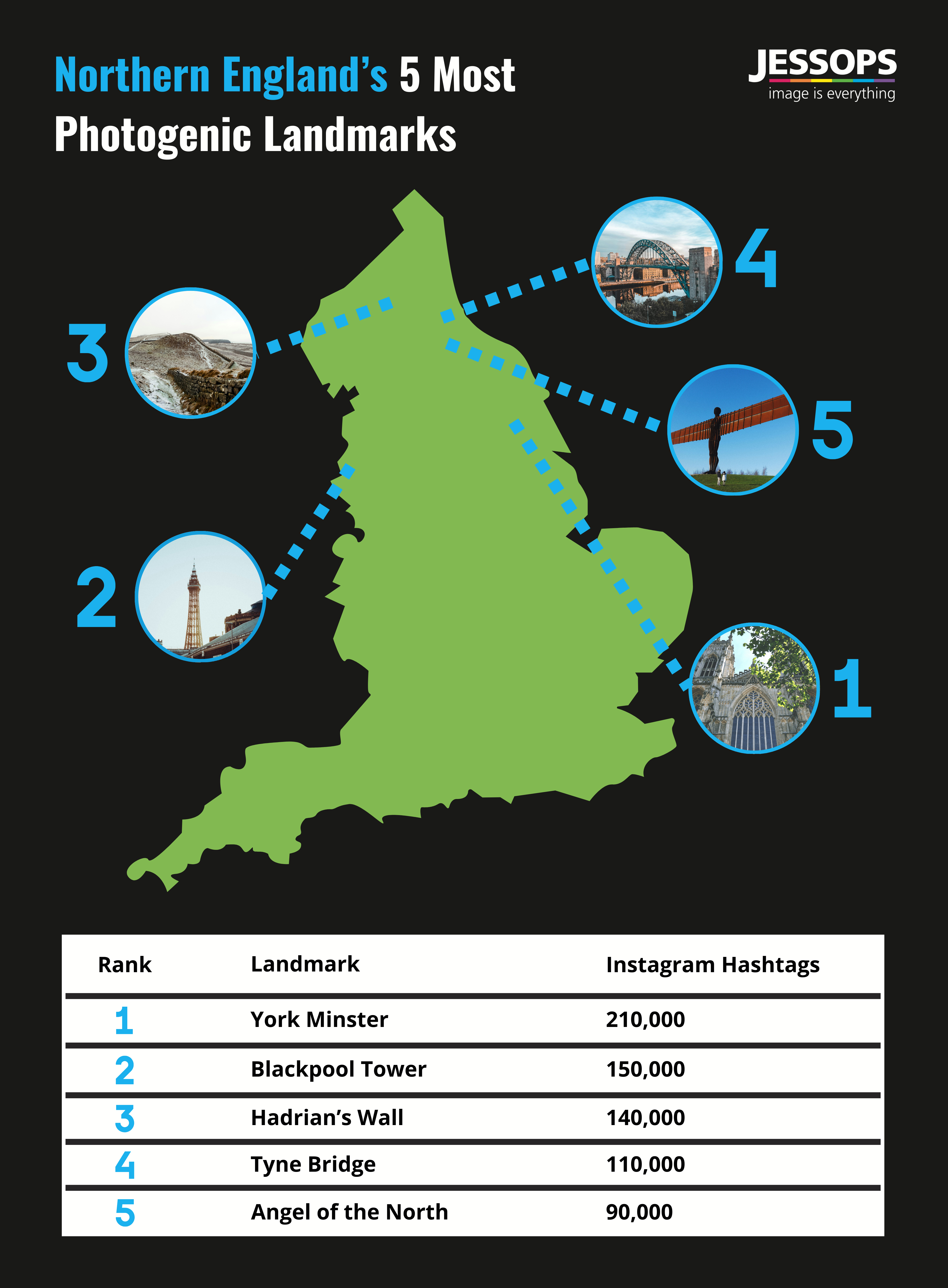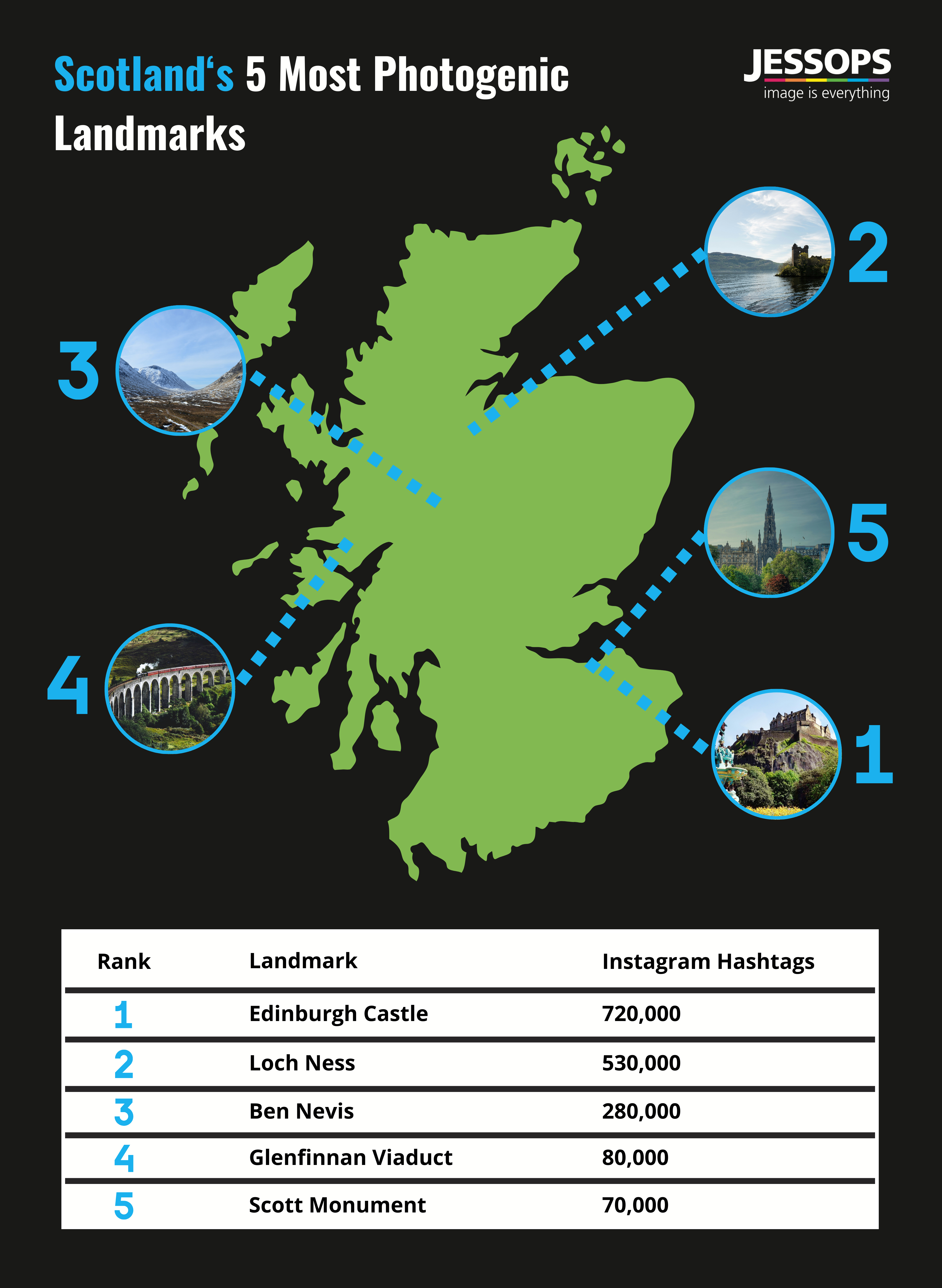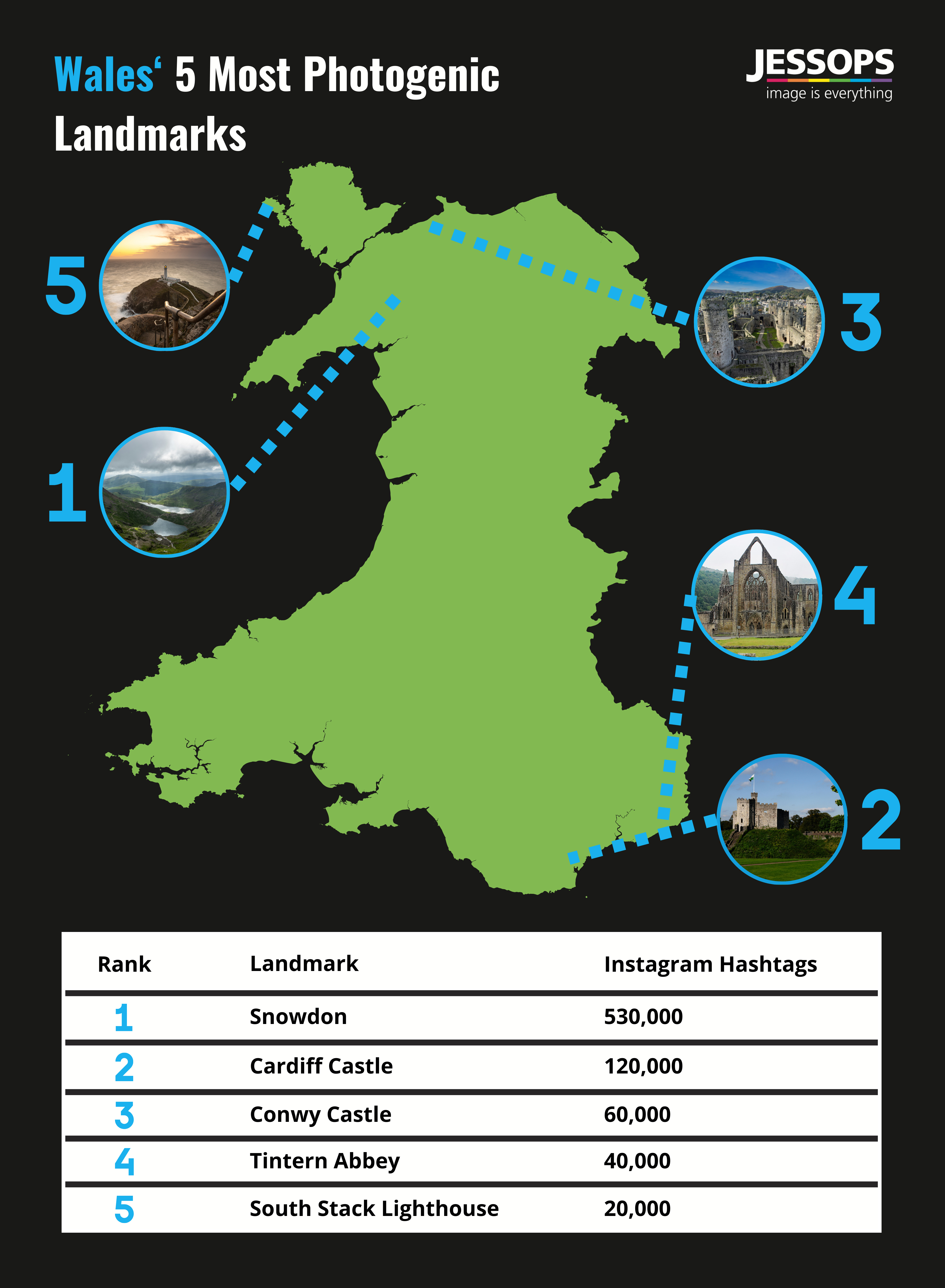
The UK’s top 10 most photogenic landmarks

From the iconic London Eye to the picturesque Snowdonia National Park, the UK is home to many stunning landmarks that pay homage to its rich history. But when it comes to the most papped locations, what are they?
To uncover the answer, we compiled a list of the UK's most renowned landmarks and ranked the top 10 based on Instagram hashtag data. We've also listed the top 5 most photographed locations in Northern England, Scotland and Wales.
To help you take stunning photos on your next trip, we've asked Product Specialist Lizzie James at Jessops for her top tips on taking the perfect landscape photo with a digital camera.
Contents
The UK’s most photogenic landmarks overall
The 5 most photogenic landmarks in Northern England
The 5 most photogenic Scottish landmarks
The 5 most photogenic Welsh landmarks
How to take the perfect landscape shot with a digital camera
The UK’s most photogenic landmarks overall

The London Eye
Offering stunning views against the backdrop of London's iconic skyline, it's no wonder this giant wheel is the most photographed location in the UK, according to Instagram data.
Whether framed against the vibrant colours of a sunset or illuminated by the city's twinkling lights at night, the London Eye provides endless opportunities for photography.
Big Ben
Standing tall and majestic amidst the hustle and bustle of London, Big Ben is another iconic landmark for capturing quintessential London scenes.
“Navigating the crowds in Parliament Square to capture Big Ben can be a bit of a challenge,” says Lizzie. “So, taking a stroll over Westminster Bridge is usually a little quieter. Plus, Big Ben won’t be towering directly over you, and you could even include a nice shot of the Thames as well.”
“For the best chance at snagging an uninterrupted shot, consider heading out during the early morning or late evening when the crowds have thinned out. You’ll have a bit more space to carefully plan your shot.”
Tower Bridge
Tower Bridge in London offers fantastic photo opportunities, especially from the promenade at Potters Fields Park. Here, you can capture the bridge against a clearer backdrop, ensuring it takes centre stage in your photographs.
Sunset is a great time to capture Tower Bridge in all its glory, casting a magical glow over this beloved landmark.
Buckingham Palace
Buckingham Palace, a symbol of British royalty, is right up there with the most scenic UK landmarks. Visit early morning to beat the crowds or even include passersby in your shots to capture the lively atmosphere.
Lizzie says: “The focus of your image doesn't have to be the building itself. Why not snap a picture of one of the guards stationed at the front gate or the flower gardens with the palace in the background? You could even zoom in on the palace's architecture to highlight the intricate details.”
Image is by Debbie Fan on Unsplash
Stonehenge
As one of the UK’s most historic locations, it’s no wonder Stonehenge is fifth in the most photographed locations. Visiting this structure is on many people’s bucket lists, and for good reason.
You can capture a stunning shot of it any time of the day, but sunrise and sunset are when the magic truly happens. With the sun lower in the sky, its golden rays illuminate the ancient stones, casting mesmerising shadows and adding depth to your photos.
"If you're shooting in low-light conditions, you might need to use a higher ISO, like 800, to allow your camera to gather more light for crisp, clear photos," says Lizzie. "Try experiencing different ISO values to find the perfect one."
Don’t let a gloomy day deter you, either. Clouds in the sky can actually enhance your shot, adding character and interest to the scene.
Natural History Museum
The Natural History Museum in London is a photographer's paradise. While the building itself is a sight to behold from the outside, plenty of fascinating photo opportunities are also waiting to be discovered inside.
If you're snapping the famous blue whale skeleton suspended from the ceiling, try angling your camera upward to avoid capturing people walking below in the frame.
Image is by Mattyas Lamar on Unsplash
Edinburgh Castle
Edinburgh Castle is a true icon, perched high above the city on Castle Rock, offering breathtaking views across the city.
There are plenty of spots to capture its beauty, but one of the best is at Ross Fountain in Princes Street Gardens. From here, you can admire not only the castle but also the picturesque gardens and fountain.
Tower of London
The Tower of London, found on the north bank of the River Thames, is a historic castle with a rich past. Initially a royal palace, it later transformed into a fortress, prison, and treasury.
Today, it's a top tourist spot, attracting visitors and photographers from around the world!
Image is by Joseph Gilbey on Unsplash
St Paul’s Cathedral
Completed in 1710, St Paul's Cathedral has since become one of the most recognisable landmarks in the UK.
It's renowned for its stunning architecture, featuring a magnificent dome that dominates the London skyline. Its grandeur, intricate details, and historical significance make it a popular subject for photographers.
Whether you're shooting from Millennium Bridge or nearby side streets, there are endless angles to photograph St Paul's from.
Snowdon
Nestled in Gwynedd, Wales, is Snowdon – the tallest mountain in Wales and England. The highest peak, Yr Wyddfa, reaches 1,085 meters (3,560 feet) above sea level!
With hiking trails for all skill levels, It's a haven for landscape photographers, offering stunning views of the Snowdonia mountain range from its summit. The ever-changing weather adds drama to shots, with fog, sunsets, and clear skies.
The 5 most photogenic landmarks in Northern England

York Minster
York Minster, a majestic Gothic cathedral nestled in the historic city of York, is the most photographed landmark in the North, according to Instagram data.
The towering spires, intricate stone carvings, and magnificent stained glass windows make it the perfect photography subject.
Blackpool Tower
Blackpool Tower is one of the most easily recognisable landmarks in the UK.
Whether you're capturing the views from its summit, the lively glow of its lights at night, or the bustling promenade in the background, you'll have plenty of interesting scenes to work with.
Image by Josh Couch on Unsplash
Hadrian’s Wall
Hadrian's Wall is a cherished spot in the North that was made a World Heritage Site in 1987. It’s also a top pick for photographers.
This ancient Roman wall, stretching across the landscape, features captivating ruins and scenic views that make for stunning shots.
Image by Toa Heftiba on Unsplash
Angel of the North
The Angel of the North in Gateshead is a gigantic sculpture of an angel with wings spread wide.
“It's a popular subject for photography because of its impressive size and striking appearance,” explains Lizzie. “The shiny metal catches the sunlight, making it sparkle and shine in photos. Plus, its location on top of a hill gives you a great view of the surrounding countryside.”
The 5 most photogenic Scottish landmarks

Loch Ness
This deep, freshwater loch is renowned worldwide, mainly due to the mysterious creature said to inhabit its depths – the infamous Loch Ness Monster!
One of the best ways to experience its beauty is by taking a boat excursion. Drifting along the serene waters, you'll be treated to panoramic views of the surrounding hills and lush forests mirrored in the glassy surface of the loch.
Image by Ramon Vloon on Unsplash
Glenfinnan Viaduct
Another location in the Scottish Highlands is Glenfinnan Viaduct. Its sweeping arches and dramatic backdrop make it an iconic sight – especially for Harry Potter fans!
Capturing a shot with a train chugging along the viaduct is the ultimate goal. So, if you're lucky enough to witness this scene, don't miss your chance to snap it!
Scott Monument
The Scott Monument is dedicated to Sir Walter Scott, a renowned Scottish author and poet. It's the world's second-largest monument to a writer!
The elaborate design, featuring many statues and intricate carvings, makes it an excellent subject for photographers. Plus, its location in the heart of Edinburgh offers stunning backdrops.
The 5 most photogenic Welsh landmarks

Cardiff Castle
Cardiff Castle stands as one of Wales' most visited tourist attractions, boasting a rich history dating back to medieval times. It's right in the heart of Cardiff's city centre.
Climb to the castle's summit, and you'll be rewarded with breathtaking views of the city below!
Image by Charlie Seaman on Unsplash
Tintern Abbey
Tintern Abbey is a masterpiece of British Gothic architecture, now a majestic ruin standing without a roof on the banks of the River Wye.
Photographers visiting the abbey can snap breathtaking shots by embracing the natural elements, like the sun peeking through gaps in the walls, casting dramatic shadows.
South Stack Lighthouse
Built in 1809, the South Stack Lighthouse sits atop a tiny island off the northwest coast of Holy Island in Anglesey.
Whether to admire the sweeping views of the surrounding landscape or the puffins nesting on the cliffs, thousands of visitors are drawn to the lighthouse every year.
How to take the perfect landscape shot with a digital camera
“Landscape photography involves capturing scenes where the width of the image or page is greater than its height,” explains Lizzie. “It's similar to the wide view you see when looking at the horizon, stretching from left to right. It's the perfect composition for snapping pictures of expansive landscapes like mountains, beaches, forests, and landmarks like bridges, castles, and more.”
Here are five simple tips to help you take stunning landscape shots with your digital camera during your next trip!
Take advantage of natural light
Lizzie says: "Natural daylight, particularly during the ‘golden hours’ just after sunrise and before sunset, is often preferred for landscape photography. During these times, the light is softer and warmer, casting long shadows and adding depth and atmosphere to your scene."
Use a tripod
“A tripod can help you stabilise your camera and ensure sharp, clear shots,” explains Lizzie. “This is especially important when using a slow shutter speed to achieve long exposure effects like capturing the flow of water or the movement of clouds in the sky.”
“With a tripod, you can confidently set up your camera for longer exposures without worrying about blur caused by camera shake.”
Experiment with angles
Lizzie recommends: “Instead of sticking to the usual viewpoints, why not try something a bit more creative?”
“Take, for instance, shooting a lighthouse. Instead of just focusing on the building, you might shoot seabirds soaring overhead or the landscape surrounding the structure. You could get down low, even lay on the ground, or find a higher spot for a unique perspective. It's all about discovering those unexpected angles that make your photos stand out from the rest.”
Choose a low ISO
ISO is a camera setting that controls your camera's sensitivity to light," explains Lizzie. "By adjusting it, you can brighten or darken your image."
"When you're out shooting landscapes, especially during the day when there's plenty of light, sticking to a low ISO is key. Aim for an ISO of between 100 and 400 to maintain that perfect balance of exposure and image quality."
For a quick lesson on this camera setting, read our beginner's guide to ISO in photography.
Edit your photos
Lizzie says: "Once you've captured your landscape shots, don't forget the power of editing! With photo editing software, like Adobe Lightroom or Capture One, you can tweak things like exposure, contrast, colours, and sharpness to really make your images pop."
To learn more, read our guide on the best photo editing software for beginners.
Capture stunning images on your next trip with Jessops
Lizzie says: "A bit of planning ahead and ensuring you've got the right gear can really step up your photography game. If you don't already have one, consider upgrading from your phone to a digital camera - you'll be amazed at the difference it can make to the quality of your images!"
Whether you're admiring the natural beauty of Loch Ness or the hustle and bustle of London's iconic landmarks, we have a wide range of products to improve your photography. Discover our range of digital cameras and lenses, as well as accessories like tripods and lighting.
If you need more advice and inspiration, check out our blog. If you have any questions or you're unsure about which product is right for you, contact us today.
Sign up for our latest news and offers
Receive the best offers right to your inbox by signing up to our newsletter
Thank You



























